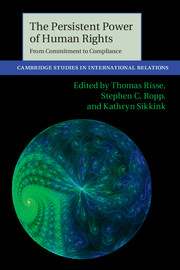Book contents
- Frontmatter
- Contents
- Figures
- Tables
- Contributors
- Preface
- Part I Introduction and stock-taking
- 1 Introduction and overview
- 2 The power of human rights a decade after
- 3 From ratification to compliance
- Part II Conceptual and methodological issues
- Part III From ratification to compliance
- Part IV From commitment to compliance
- References
- Index
1 - Introduction and overview
Published online by Cambridge University Press: 05 March 2013
- Frontmatter
- Contents
- Figures
- Tables
- Contributors
- Preface
- Part I Introduction and stock-taking
- 1 Introduction and overview
- 2 The power of human rights a decade after
- 3 From ratification to compliance
- Part II Conceptual and methodological issues
- Part III From ratification to compliance
- Part IV From commitment to compliance
- References
- Index
Summary
More than ten years ago, Thomas Risse, Stephen Ropp, and Kathryn Sikkink co-edited The Power of Human Rights: International Norms and Domestic Change, a volume whose centerpiece was a spiral model of human rights change (PoHR in the following, see Risse et al. 1999). PoHR was published on the occasion of the fiftieth anniversary of the Universal Declaration of Human Rights and ten years after the peaceful revolutions in Central Eastern Europe which then ended the Cold War. More than a decade later, dictators are on the run in the Middle East. These political changes in Tunisia, Egypt, Libya, and elsewhere are having profound effects on this region of the world, including the human rights situation there (see Chapter 10).
Over the past ten years, human rights policies have also changed considerably: First, we witness the gradual emergence of a new model of criminal accountability used by states acting collectively through the International Criminal Court (ICC) to hold individuals responsible for human rights violations (Deitelhoff 2006; Sikkink 2011). And a new international norm has emerged, the Responsibility to Protect (R2P), referring to the responsibility of the international community to intervene – by military means, if necessary – if state rulers are unwilling or incapable of protecting their citizens from gross human rights violations (Evans 2008; Weiss 2005). R2P was recently put to a test with the Western intervention in Libya which had been endorsed by the United Nations Security Council and backed by the Arab League as well as the domestic opposition in Libya.
- Type
- Chapter
- Information
- The Persistent Power of Human RightsFrom Commitment to Compliance, pp. 3 - 25Publisher: Cambridge University PressPrint publication year: 2013
- 63
- Cited by

